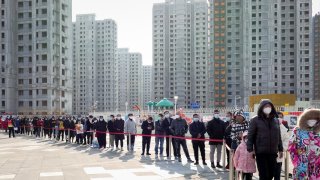
- As Chinese local authorities impose more travel restrictions and a few lockdowns to contain the omicron Covid variant, analysts are turning cautious on China's economy.
- The greatest impact of the zero-Covid policy has been on hotels and restaurants, according to analysis from Dan Wang, Shanghai-based chief economist at Hang Seng China.
- China's "zero-Covid policy can one hand ensure the retail activity, industrial activity can carry on, but if the world is successful in the way of 'living with [the] virus,' China may risk the growth divergence between the two," said Gary Ng, Asia-Pacific economist at Natixis.
BEIJING — China's zero-Covid policy for controlling the pandemic affects consumers more than factories, economists say.
As local authorities impose more travel restrictions and a few lockdowns to contain the omicron Covid variant, analysts are turning cautious on China's economy. Goldman Sachs cut its growth forecast for the year on Tuesday.
But the analysts focused on the impact to China's already sluggish consumer spending.
Feeling out of the loop? We'll catch you up on the Chicago news you need to know. Sign up for the weekly Chicago Catch-Up newsletter here.
Omicron's high transmissibility means the costs of China's zero-Covid policy are rising, while benefits are falling, Nomura's Chief China Economist Ting Lu said in a report Monday. He noted how in hospitality, business has yet to recover to pre-pandemic levels and industry workers might be draining their savings and spending less.
Not on the list of costs was manufacturing.
On the positive side, "the zero-Covid strategy, plus Beijing's ability to mobilize all the country's resources, has arguably brought significant benefits to its people and economy, with an official death count of just four since mid-April 2020, factories firing on all cylinders, and an impressive 31.0% [year-on-year] export growth in the first eleven months of the year," Nomura's Lu said.
Money Report
Since the pandemic began in early 2020, China's policy has used quarantines and travel restrictions — whether within a city or with other countries — to control outbreaks. After a first-quarter contraction, the country became the only major economy to grow that year.
The greatest impact of the zero-Covid policy has been on hotels and restaurants, according to analysis from Dan Wang, Shanghai-based chief economist at Hang Seng China. Manufacturing and agriculture were the least affected and have contributed the most to growth, her study found.
Wang's analysis compared GDP figures in 2020 and 2021 to a four-year average of China's annual GDP growth rate between 2016 and 2019, before the pandemic.
"By containing the Covid spread, China [has] been able to make sure that all nodes along the supply chain worked so that actually agricultural and industrial output ... have both been higher than the trend value," she said in a phone interview last week.
Industrial production grew by 2.8% in 2020 and rose by 10.1% in the first 11 months of 2021 from the same period a year ago. China's factory activity unexpectedly increased in December, according to an official measure called the Purchasing Manager's Index.
Why factories are less affected
Although China's economy faces a number of challenges from surging commodity prices to a crackdown on the massive real estate industry, economic data indicate resilience in factory production.
In China, manufacturers are less affected by city lockdowns since factories are typically spread out in suburban industrial parks, where employees live in dormitories, said Yue Su, principal economist at The Economist Intelligence Unit.
She noted how Apple supplier Foxconn was able to maintain production at its factory in Zhengzhou, Henan, this past summer despite historic flooding that killed more than 300 people in the province.
Su expects different local government approaches to implementing a zero-Covid policy will result in varying economic performance by province this year.
"For example in Shanghai, when there is a positive case, they will only lock down the district or the street," she said. "But for governments that have limited healthcare resource[s], they tend to lock down the whole city immediately, like what happened in Xi'an."
Xi'an in central China is one of the country's many industrial hubs. The lockdown since late December of a city of 13 million people contributed to Citi Chief China Economist Li-Gang Liu's expectation that industrial production could fall to 3.5% year-on-year growth in December, from 3.8% in November.
But Liu expects China's trade growth "to remain robust" despite a high base of the last two years.
More than half of China's goods manufactured for export come from the provinces of Guangdong, Jiangsu and Zhejiang, on the south or southeastern coast near Shanghai. The less developed areas lie in the central and western parts of China, a country of 1.4 billion people.
China's export growth remained resilient throughout 2021, despite multiple warnings of slowing demand from overseas.
The risk is this time around, factories in other countries may be able to operate if their governments decide to pursue a strategy of coexistence with Covid.
China's "zero-Covid policy can one hand ensure the retail activity, industrial activity can carry on, but if the world is successful in the way of 'living with [the] virus,' China may risk the growth divergence between the two," said Gary Ng, Asia-Pacific economist at Natixis.
Political risks
Analysts expect China will stick to the zero-Covid policy through the end of this year due to politically important events, from the Beijing Winter Olympics in February to a Chinese Communist Party leadership meeting expected in the fall.
That adds pressure to local government leaders, who are often fired after a surge of Covid cases in their city.
The stringent policy has become politically sensitive in other ways. U.S.-based consulting firm Eurasia Group on Jan. 3 named the top risk for 2022 as China's failure to achieve zero-Covid, requiring more severe lockdowns and adding to supply chain disruptions. Chinese state media swiftly criticized the report with English-language opinion pieces and a cartoon.
Authorities are also concerned about the country's already tight hospitalization capacity.
China's Center for Disease Control and Prevention published a study in November that said shifting to the coexistence strategy of other countries would likely result in hundreds of thousands of new daily cases and devastate the national medical system.
The omicron Covid variant that emerged in late November is a heavily mutated version of the coronavirus that's highly transmissible.
Initial reports indicate omicron may be less fatal than other Covid strains. But the World Health Organization said Tuesday that omicron can result in life-threatening illness for the unvaccinated, the elderly and people with underlying conditions.
Mainland China reported 124 new, locally transmitted cases for Wednesday, for a total of 3,460 existing cases — and no new deaths. New cases in Xi'an city fell to six, down from 63 a week earlier. In the U.S., deaths from Covid average 1,700 a day, while hospitalizations hit a record 132,646 people as of Monday, according to Reuters.






